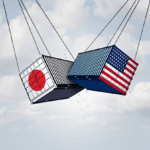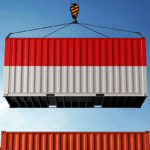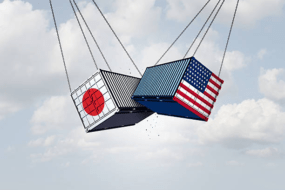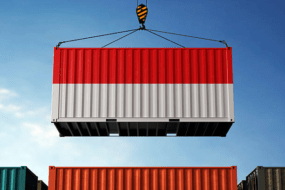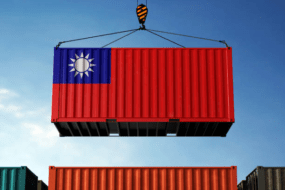- Home
- Trade News
- Upsurge for Exports of Thailan ...

Despite a fractured global economy and intensifying trade rivalries, Thailand has staged one of the region’s most compelling export rebounds in 2025.
In a year of uncertainty, the kingdom’s success story, led by soaring electronics shipments and resilient agriculture exports, offers more than good numbers. It signals a strategic shift.
What began as a measured policy response is now unfolding into a broader economic play that could reshape Southeast Asia’s trade map trajectory.
Thai Agriculture Rising Despite Global Volatility
Thailand’s agricultural exports hold their own, even as global food trade faces unpredictable price swings and supply challenges. Behind the performance are decades of farm-sector resilience and timely policy support.
Fruit and Rice Continue to Anchor Rural Income
Agriculture may not be the most captivating sector, but it remains the bedrock of household income for Thai industries rooted in rural areas. And in 2025, that bedrock is holding firm.
Fruit exports, particularly durian, mango, and longan, have seen impressive volume and value increases, contributing significantly to the country’s food industry performance.
However, the situation for rice, Thailand’s iconic export, is more challenging. While it remains a crucial commodity, shipments in 2025 have declined compared to last year’s strong performance.
This is due to intensified global price competition, particularly with India’s resumption of white rice exports, and changing import demands from key markets.
Ministry Initiatives Strengthening Food Export Chains
Behind this growth is more than just fertile soil. The Ministry of Commerce and the Ministry of Agriculture have ramped up infrastructure support, investing in cold-chain logistics, export certification programmes, and digital tracking for farm goods.
These initiatives are also helping Thailand align more closely with global standards, particularly as goods and services regulation becomes more complex, trade links strengthen, and the annual value of even traditional commodities increases.
Thailand’s Electronics Sector Powers Through Supply Chain Shifts
While many countries are still catching up to post-pandemic supply chain shifts, Thailand is already building momentum in the tech manufacturing space. Electronics are fast becoming the heart of the country’s export engine.
Integrated Circuits Lead the March
It may come as a surprise, but Thailand is quickly becoming one of Asia’s quiet tech achievers. The country’s electronics exports surged in the first quarter of 2025, making it one of the top exports of the year.
While most headlines focus on heavyweights like China or Singapore, Thailand has positioned itself as a reliable second-tier hub. Lower labour costs, political stability, and proximity to regional markets are attracting foreign investment, particularly in the semiconductor space.
Powering Through Global Competition
Notably, this economic growth in tech is happening even as global demand shows signs of cooling. That suggests Thailand’s growth is structural. In other words, the country has improved its internal capacity to produce, compete, and export.
The private sector has also been a key player, with major local and foreign firms expanding operations outside Bangkok into regional manufacturing zones. This deconcentration is a healthy sign, which spreads risk, builds talent in new areas, and supports longer-term economic expansion.
Southeast Asia & Beyond: Diversifying Thailand’s Export Markets
As demand shifts across regions, Thailand is learning to hedge its bets. Instead of relying too heavily on one or two markets, the country is taking a more balanced approach, strengthening trade ties across Asia and beyond.
High Demand from China and the US
Diversifying markets is always complex, but Thailand is demonstrating steady progress. As of May 2025, the United States and China continue to be primary destination markets, particularly for electronics and processed foods, driving significant export growth.
Despite global geopolitical uncertainties that could threaten trade stability, Thai exporters are proactively pursuing bilateral agreements, especially with Asia-Pacific partners.
This strategy aims to reduce dependency on any single country, which is prudent as more economies navigate potential tariff talks with Washington.
Trade Surplus Amid Rising Imports
Interestingly, while imports are also on the rise, primarily due to increased orders of raw materials and capital machinery for future production, Thailand successfully posted a merchandise trade surplus of US$3.4 billion in May 2025.
This surplus reflects strong export performance and indicates that the domestic market is actively investing and preparing for increased output.
The numbers suggest a country that is not merely reacting to global conditions but actively planning its future role in international trade, strategically enhancing its internal capacity to produce, compete, and export.
Thailand’s Economic Expansion and Export-Led Growth Strategy
While domestic consumption continues to face challenges, exports remain a critical engine for Thailand’s GDP growth. The country’s strategy this year is clear: strategically leverage external markets while actively supporting local industries to enhance their competitiveness and capacity.
World Bank Downgraded its 2025 GDP Projections
Despite an accelerated export performance in the first quarter of 2025, which the World Bank acknowledges was largely temporary due to factors like advance shipments before potential trade policy shifts, their outlook for Thailand’s economy in 2025 has become more cautious.
As of early July 2025, the World Bank has revised its full-year GDP growth forecast significantly downward to around 1.8%.
This substantial revision stems from concerns over ongoing global trade policy uncertainties expected to weigh on exports in the latter half of the year, alongside persistent weak domestic demand exacerbated by high household debt.
The Current Administration’s Proactive Trade Policy
Much of Thailand’s current trade momentum results from coordinated policy efforts by the current government.
The administration has consistently prioritised global engagement and openness, actively working to secure preferential trade deals, expand digital infrastructure, and attract more export-oriented private sector investment.
Critical Role of Economic Institutions and the Private Sector
Thailand’s export strength in 2025 is not an overnight phenomenon. It reflects years of institutional groundwork and a dynamic private sector, which are being tested as global competition tightens and trade landscapes shift.
Export Growth Supported by Private-Sector Investment
The export narrative of 2025 is indeed significantly shaped by private-sector initiatives. Thai manufacturers, particularly in the electronics and processed food industry clusters, are demonstrating strategic expansions.
From integrated circuits and computer components to processed fruits like frozen mango, companies are investing in better technology, enhancing staff training, and optimising end-to-end logistics to boost production and export capabilities.
Furthermore, exporters are increasingly engaging in strong public-private collaboration with economic institutions. This partnership is crucial for ensuring alignment with evolving trade compliance rules and international standards in key markets such as China, Australia, and Vietnam.
This level of cooperation marks a significant advancement from a decade ago, when policy implementation sometimes lagged behind the rapid changes in business needs.
Thailand’s Response to the 1997 Asian Financial Crisis is Still Relevant
If 1997 taught Thailand anything, it was that external shocks don’t wait for economies to be ready. The Asian financial crisis led to painful reforms and laid the foundation for the country’s resilience. The country now has stronger capital controls, more agile institutions, and a diversified export portfolio.
Even today, foreign debt levels remain manageable, while the central bank continues to monitor liquidity buffers. That legacy protects the Thai economy in a world where unexpected headwinds are more common than tailwinds.
Factors Impacting Future Export Performance
Momentum is good, but not guaranteed. Several risks, from tariffs to talent shortages, could slow Thailand’s export growth. The challenge now is staying one step ahead of them.
Geopolitical Shifts and Tariff Pressures
All eyes are currently fixed on the July 2025 deadline, as the existing tariff moratorium between Thailand and the United States approaches its expiration. Intensive negotiations are underway in Washington, D.C., with Thailand’s Deputy Prime Minister and Finance Minister leading efforts to secure a favourable deal.
If no agreement is reached, top Thai exports, including computers, teleprinters, telephone sets, rubber products, semiconductors, and circuit boards, could face steep duties. While the previous 90-day pause capped tariffs at a 10% baseline, the US has threatened to impose levies as high as 36% if no reduction is negotiated.
Thailand’s National Economic and Social Development Council (NESDC) projections suggest the country could face an 18% US tariff if a more favourable deal isn’t secured, based on comparisons with agreements reached with other nations like Vietnam (now at 20%).
Skilled Labour and Manufacturing Capacity Constraints
Even with soaring demand, there’s a bottleneck no one can ignore: workforce capacity. Thai exporters face a significant shortage of skilled labour, particularly in manufacturing and engineering.
With expansion underway, the need for trained technicians, machine operators, and digital supply-chain analysts has risen dramatically. The risk is that export growth may hit a ceiling without faster training pipelines and stronger education–industry coordination.
Data Snapshot: Thailand’s Performance for 2025
The numbers offer more than just bragging rights. They reveal which industries drive Thailand’s rise and where imports are quietly growing to support the next expansion phase.
Key Export Metrics and Top Performing Industries (January – May 2025)
According to official data, Thailand’s total exports from January to May 2025 reached approximately US$138 billion, marking a strong 14.9% year-on-year growth. This indicates strong momentum, though some of this growth in early 2025 is attributed to accelerated shipments ahead of potential US tariffs.
Here’s where the momentum is building:
- Electronics, particularly semiconductors and integrated circuits, are a significant driver. In May alone, electronic exports surged by 217.8% (to China) and 70.9% (to Hong Kong), contributing substantially to overall export expansion.
- Agricultural exports show a mixed but generally positive picture:
- Rice exports are facing challenges, with the first quarter of 2025 seeing a 30.4% decrease year-on-year. This is largely due to increased competition from India and higher Thai prices.
- Rubber shipments increased significantly, with natural rubber exports valued at US$2.008 billion from January to April 2025, marking a 23.20% increase year-on-year.
- Processed foods are performing well. For the first three months of 2025, key agro-industrial products like pet food grew by 12.5% and canned and processed fruits by 16.0%.
- The automotive sector had a mixed performance, dominated by a shift towards EVs:
- While overall finished vehicle exports dropped by 9.2% year-on-year in May 2025, reflecting declines in traditional sedan models to the US and Europe due to stricter regulations, the growth in EV manufacturing is indeed explosive.
- Battery Electric Vehicle (BEV) production surged by 641.16% year-on-year in May 2025, and Plug-in Hybrid Electric Vehicle (PHEV) production rose by 130.49% year-on-year in the same month.
- Meanwhile, machinery and industrial equipment, often overlooked, are strong contributors. Exports of machinery and mechanical components grew by 17.3% in the first three months of 2025. Specific components:
- Steel and iron products grew, with overall metal products exports increasing by 16.4% in May 2025.
- Air conditioners and components exports rose by 19.1% in Q1 2025.
Imports Also Growing, Driven by Energy and Machinery
It’s not just that outbound trade is surging. Imports of critical goods are also rising, driven by Thailand’s ongoing industrial build-out and domestic demand. In May 2025, total imports increased by 18.0% year-on-year, reaching a record high. In particular:
- Fuel imports and a general increase in raw materials and intermediate goods (up 19.3% in May 2025) reflect higher domestic and manufacturing demand.
- Capital goods imports, including high-grade machinery and equipment, surged 41.1% in May 2025, directly fueling local production capacity and modernisation efforts.
Conclusion: Thailand’s Export Momentum Is Real But Not Risk-Free
So, are the exports of Thailand all smooth sailing? The strong showing in electronics and agriculture tells us this isn’t just about catching a wave of global demand. Rather, Thai exports are actively repositioning the country within regional and international supply chains.
There are still risks to monitor, especially as countries ramp up trade activities that may disrupt existing balances. And let’s not forget, this is all playing out during a sensitive period where over 50 nations are lining up to renegotiate terms with the US. Any exporter banking on stability will need to prepare for some turbulence ahead.
At TradeDataPro, we track these market movements so you don’t have to rely on outdated forecasts or generic reports. Whether it’s Thailand’s latest trade surplus, changing export profiles in Southeast Asia, or unexpected policy shifts from major economies, keeping tabs on trade flow patterns is now less optional and more essential.


